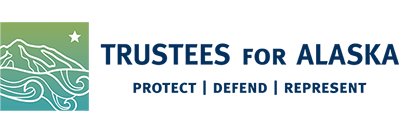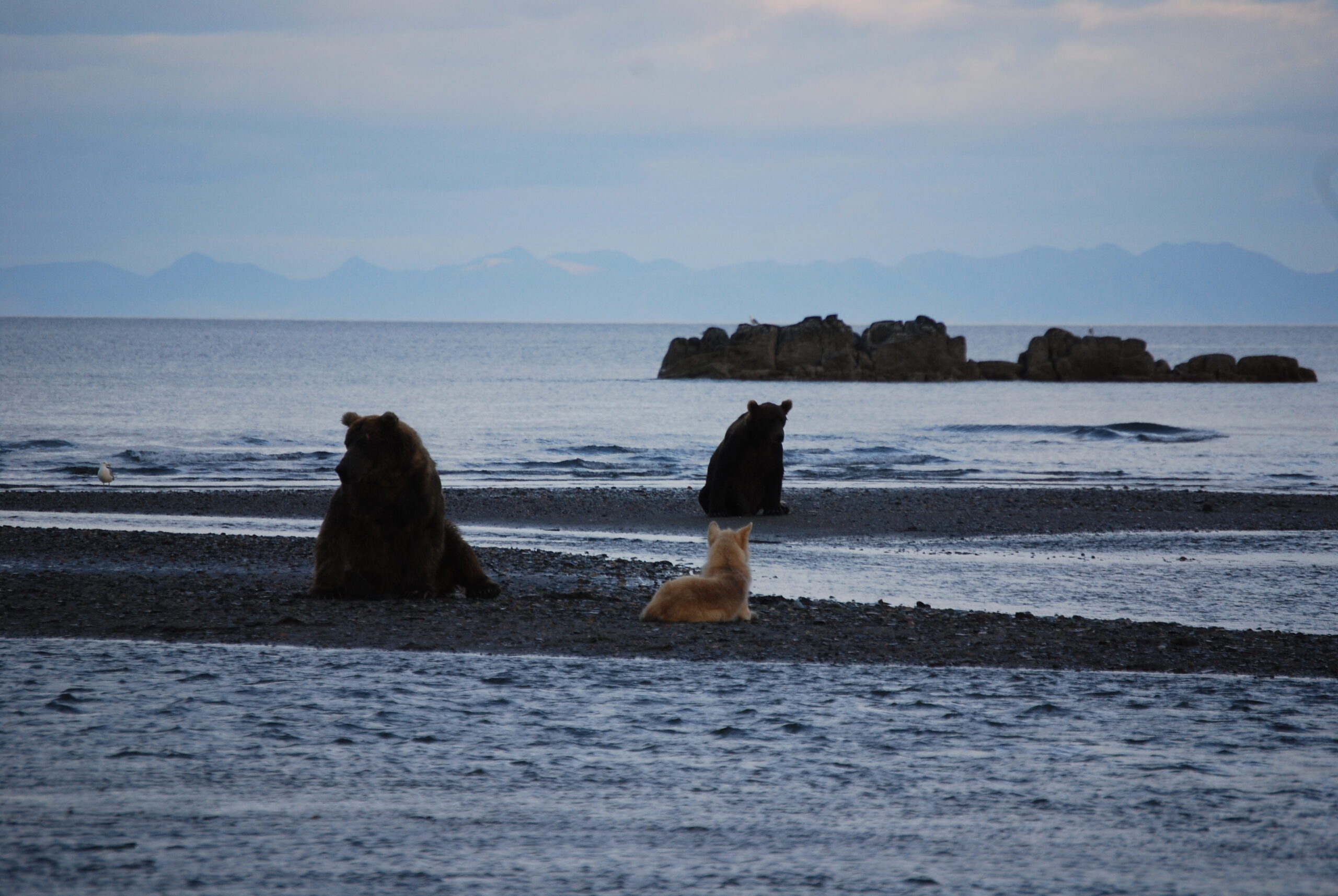
Beyond control: The fight for science, ethics, and coexistence in Alaska’s predator policies
By Madison Grosvenor
Last month’s court ruling that found the State of Alaska’s Mulchatna predator control program illegal marked a crucial victory for bears and the health of wildlife in Alaska. It also came as a stark reminder of how far state wildlife policy has strayed from science, ethics, and ecological balance.
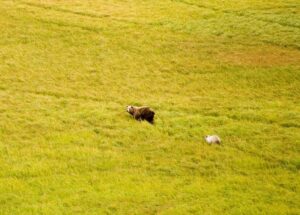
An aerial view of a female brown bear and her cub venturing through a green field. Photo by Ryan Hagerty, USFWS.
Yet, with the ink barely dry on the court’s decision, the Alaska Board of Game rushed to reinstate aerial gunning of bears and wolves, defying both a court order and public outcry.
Just as outrageous, the Board of Game doesn’t know how many bears inhabit the area in the first place, nor what their wholesale slaughter will do to the sustainability of the population and all the plants and animals who rely on these bears to play a key role in the health of the ecosystem.
“To date, ADFG still has still not presented any information about how the Mulchatna predator control program has or will impact bear populations, and it has no baseline data on bear population levels or dynamics before it started unlimited aerial gunning during the control period,” said Nicki Schmitt, Alaska Wildlife Alliance’s executive director. “Essentially, the State says, ‘trust us, the bear population will be fine’ without any citable data.”
Beyond the sleight-of-hand
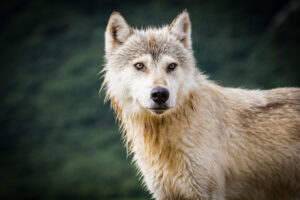
Coastal wolf near Katmai National Preserve. Photo by D. Kopshever, NPS.
This month we go beyond the bureaucratic sleight-of-hand and courtroom drama outlined in last month’s predator control to ask bigger, perhaps more uncomfortable questions: What does wildlife science say about predator-prey dynamics? Who benefits from killing wolves and bears under the banner of “management”? And perhaps most revealing… why are we still so afraid of predators in the first place?
Because when we strip away the camouflage of policy language and politics, we’re left with a deeper reckoning: Alaska’s predator control programs aren’t just a test of wildlife science. They’re a mirror reflecting how we, as humans, relate to other animals and “the wild,” often choosing domination over coexistence.
Predator control programs in Alaska have historically lacked a foundation in sound scientific practice, with inconsistent biological standards and insufficient evaluation protocols. Since the late 1940s, many of these programs were based on incomplete or low-quality data and often proceeded without clear methods for monitoring outcomes and yielding unclear results. When the State took over wildlife management in 1959, it was no different.
Although an emergency standard for justifying control programs, introduced in the late 1980s, attempted to incorporate more rigorous criteria, such as requiring evidence that predation was the primary cause of ungulate decline, this short-lived approach failed to change the state of play.
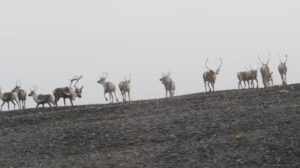
Mulchatna caribou herd. Photo courtesy of Alaska Department of Fish and Game.
The 1994 Intensive Management statute shifted the focus from formal protocols and more rigorous criteria to maximizing hunting opportunities by mandating the restoration of ungulate populations largely through predator reductions where seasons were lengthen, sometimes again and again, harvest limits increased, sometimes again and again, various means and methods were relaxed and some tag fees were eliminated. All this, regardless of habitat conditions or broader ecological factors which many users observed were happening. This policy shift effectively sidelined scientific assessments in favor of politically driven management objectives.
Still, today, when approving the Mulchatna predator control program there were no baseline studies conducted to determine predator populations before heading out to aerially gun down bears and wolves.
A shot in the dark
Amid a rapidly warming climate and shifting ecological conditions, wildlife managers nationwide are encountering similar biodiversity crises. Rather than confronting the complex and systemic drivers of these changes, such as habitat degradation and climate-induced stress, many state agencies continue to blame predator animals like wolves and bears. This oversimplified approach mirrors Alaska’s legacy of sidelining ecological science in favor of politically convenient predator control, even as the root causes of wildlife decline go unaddressed.
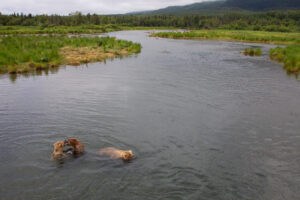
Brown bears fish and play in the river. Photo by Peter Pearsall, USFWS.
Apex predator animals play a critical role in maintaining healthy, balanced ecosystems through a process known as trophic cascade, where their presence regulates the populations and behaviors of other species, ultimately shaping vegetation patterns and broader ecological dynamics. Bears have the crucial role of seed dispersal, consuming large amounts of fruits and berries, passing the seeds through their digestive systems, and depositing them across vast distances. The dispersal process is critical for the propagation and biodiversity of plant species.
Bears and wolves also take part in nutrient cycling, dragging salmon carcasses from streams and into surrounding forests, distributing essential nutrients into the soil and fertilizing the forest’s floor.
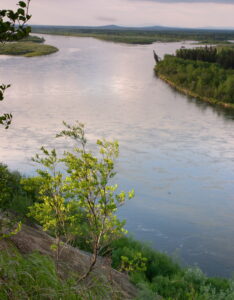
near the confluence of Nushagak and Mulchatna Rivers by Erin McKittrick
Recent ecological studies underscore that the removal or significant reduction of large carnivores can destabilize these systems, triggering a downward spiral of ecosystem simplification that may harm the very species predator control programs claim to support, including moose and caribou. When top-down regulation is lost, unchecked herbivore populations can over-browse vegetation, deplete food sources, alter habitat structure, and reduce the long-term carrying capacity for big game animals.
In Alaska, predator control policies designed to boost moose and caribou numbers for hunting have largely ignored these complex ecological interactions.
By focusing narrowly on increasing moose and caribou numbers through the killing of bears and wolves, the state’s managers risk triggering unintended ecological consequences, such as habitat degradation from overbrowsing or shifts in prey animal behavior that disrupt natural migration and calving patterns.
The Board of Game gravitates towards these immediate, tangible actions even when the true threat is right in front of them, yet they reach for guns and planes rather than real solutions.
The numbers game
The State of Alaska tends to exaggerate how much predators like wolves and bears affect moose and caribou populations, using this as a main argument for aggressive predator control programs. Their 2008 on predator management is framed as an informational overview, but it reads more like a pitch for these bogus programs rather than a balanced look at science.
A lot of the data they use lacks context or doesn’t align with what long-term studies actually show. For instance, the claim that each wolf eats up to 13 moose or 40 caribou a year is way off from actual field studies. Wolves are known to eat a variety of prey, including smaller animals like beavers and hares, in some locations fish, and they scavenge, too. Stating that they only eat moose or caribou inflates their impact. Often, bears and wolves are more likely to go after injured, diseased, or older caribou that may not have a large chance of surviving.
In fact, from 2010 to 2021, when Fish and Game actively shot wolves in the region, fewer caribou survived. There is no consistent evidence that shooting predators is boosting caribou populations.
What’s missing from the conversation is that predation is just one piece of a much bigger puzzle. Trends in moose and caribou populations fluctuate regardless of predation.
In the research article Demography of an Increasing Caribou Herd with Restricted Wolf Control, retired Department of Fish and Game wildlife biologist, Rodney D. Boertje, and others present evidence from long-term monitoring of the Fortymile caribou herd in Alaska that shows that predator control alone is not a sustainable method for managing populations of caribou. No clear improvement in caribou survival resulted despite the implementation of both nonlethal and lethal wolf control methods. Calf mortality remained high, averaging 54 percent, and adult female mortality stayed around 9 percent, both when predator control was being conducted and when it wasn’t.
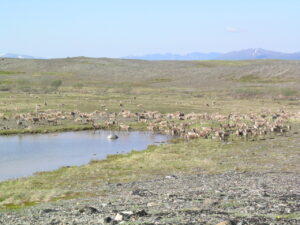
The Mulchatna caribou herd at the Telequana Corridor in Lake Clark. Photo courtesy of NPS.
Interestingly, the herd’s growth rate was highest just before any control was implemented and declined during the periods of both nonlethal and lethal control. This indicates that other factors, like food availability and habitat limitations, played a more significant role in regulating the population.
Habitat quality, weather, ever more frequent icing events, and food availability play a large role in determining how many moose or caribou survive and reproduce. The Mulchatna caribou herd has experienced a significant decline from approximately 200,000 individuals in the late 1990s to about 12,000 today.
Several studies have identified habitat degradation and disease as more significant contributors to the herd’s decline than predators. Specifically, poor body condition in female caribou, indicative of nutritional stress, and the spread of brucellosis, a disease leading to reproductive failures, have been pinpointed as critical factors affecting the herd’s survival and reproduction.
The board of game needs to manage itself
Overstating predations’ impact on populations of moose and caribou (and disregarding more significant climate impacts) fuels the fire for senseless predator control methods that end up doing more harm than good.
At its core, Alaska’s predator control policy is less of a wildlife management issue and more of a political pawn. Behind the rhetoric of “population balance” and “subsistence needs” lies a system that often serves the interests of trophy hunters, commercial big game guides, and politically influential hunting lobbies, not the health of Alaska animals.
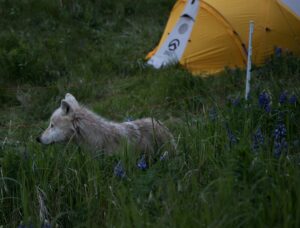
Wolf approaches a tent in Katmai NP&P Coast. Photo by J. Paluh, NPS.
Some groups support killing bears and wolves on the belief that it will make moose and caribou more abundant and easier to hunt—not just for subsistence, but also for sport and profit—because that is the propaganda that Fish and Game peddles. However, scientific evidence shows that these predator control efforts often fail to produce the intended results. This prioritization of hunting opportunities over ecological balance reveals a troubling bias in state policy, one that places economic and recreational interests above scientific evidence and long-term environmental stewardship.
When predator control becomes a mechanism to satisfy special interest groups, it ceases to be a question of management and becomes a question of morality—a question of who gets to decide which lives have value, and why. If misinformation lays the groundwork for flawed predator control policy, it is fear that often sustains it.
We are the bear
In Alaska, wolves and bears are not just ecological actors but powerful cultural symbols, often cast as threats to safety, livelihoods, and game populations. This fear, whether rooted in myth, personal experience, or sensational media, frequently overrides ecological realities and ethical considerations.
As a result, state-sanctioned killing of these animals is not only accepted but even encouraged, despite growing scientific consensus of the ecological importance of bears and wolves to entire webs of wildlife.
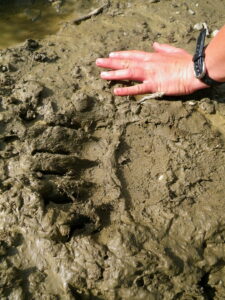
Human hand and bear paw print along the riverside. Photo by Jeremy Matlock, BLM.
It’s here that the debate enters murkier territory, not of biology, but of morality. Why is the direct response to fear too often domination?
We fear bears and wolves in part because they mirror aspects of ourselves. They are intelligent, social, territorial, and capable of both nurturing and killing. In them, we recognize our own instincts, provoking not just fear, but a primal discomfort with what we cannot control.
Sherry Simpson, in her book Dominion of Bears: Living with Wildlife in Alaska, captures this tension:
“The slightest evidence that bears share your world—or that you share theirs—can alter not only your sense of the landscape but also your sense of yourself within that landscape.”
Bears and wolves are not abstract threats; they are neighbors. Yet instead of seeing this as an invitation to coexistence, we often interpret it as an intrusion. Predator control policies are grounded less in ecological necessity and more in human anxiety.
It’s not about whether bears and wolves should live, it’s about whether we can tolerate their presence as equals, as beings with agency, rather than reduce them to enemies, threats, and pests in our largely human-centered narrative.
The path forward demands more than improved data collection or stricter legal oversight. It requires a profound shift in how we relate to wild animals and wild places. Alaska’s predator control policies reflect an outdated worldview that sees nature as something to be managed through force rather than understood through respect. It’s a worldview in which wolves and bears are problems to be eliminated rather than keystone species that help sustain entire ecosystems. Until that fundamental relationship changes, even the most well-crafted reforms will fall short of addressing the deeper issues at play.
A needless slaughter ensues
On May 7th, an Alaska Superior Court ruling reaffirmed the illegality of the State’s ongoing effort to bypass judicial oversight and public process in pushing forward the Mulchatna predator control program. By clearly stating that the Board of Game’s emergency regulation failed to address the mandates of a March court order, the Superior Court underscored that state agencies cannot simply repackage the same unlawful policy as an emergency regulation and expect to escape accountability.
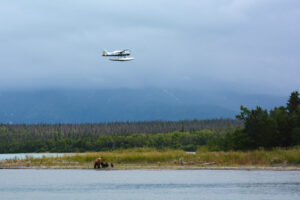
Float plane above mother bear and cubs on Naknek Lake. Photo by Paxson Woelber.
The ruling serves as a second, decisive legal blow against the State’s attempt to sidestep due process, and it preserves the March judgment that deemed the aerial gunning program void, unconstitutional, and without legal effect.
Two days later, the Department of Fish and Game announced it would proceed with the bear-removal program, claiming the emergency regulation authorized the action and was unaffected by the court ruling.
They killed 11 bears in 3 days.
However, on May 12th, Alaska Superior Court Judge Christina Rankin reaffirmed the illegality of the State’s efforts, ruling that the emergency regulation failed to meet the mandates of the March order. She stated clearly that the regulation was “invalid and without legal effect,” and criticized the State for acting in bad faith by attempting to bypass judicial oversight and due process.
With no baseline population data and no analysis of ecological impact, the continued push for aerial gunning appears not only reckless but also deliberately dismissive of both legal mandates and public opposition.
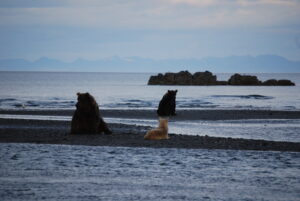
Two bears and a wolf sitting on a beach in Hallo Bay. Photo by Katie Moest.
There is another way, one rooted in coexistence and science. Other regions have shown that when predator management is guided by robust ecological research, community engagement, and a commitment to long-term ecosystem health, it can support both wildlife populations and human needs.
Alaska, with its vast wilderness and rich biodiversity, is uniquely positioned to become a model for this kind of forward-thinking conservation. But this means wisely rejecting fear-based narratives or misinformation and choosing to see predators not as enemies, but as essential partners in our collective ecosystem.
In the end, the battle over Alaska’s predator control programs is not just about bears and wolves…it’s about the kind of future we want to build, one where policy is ruled by knowledge, not fear. One where ethics and ecology are not afterthoughts, but foundations. And one where we finally learn to share the wild, rather than work to subdue it.
Will Alaska rise to meet that moment? Or will it remain trapped in a cycle of control that costs us more than we realize?
This is the second in our series on predator control. You can find the previous article below:


